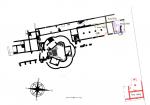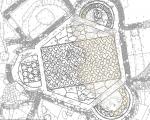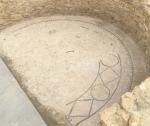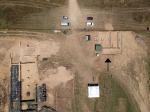Summary (English)
Four sectors were investigated in 2019: Area 7600 (Room U), Area 9700, Area 13000, and Area 14000. Generally, this involved completing the trenches begun last year (Area 7600 sometime before) in order to complete the stratigraphic sequence down to natural. In particular, in Room U, where the stratigraphy confirmed early medieval floor surfaces relating to the dismantling and recycling of the villa’s structures (cf. US 7513), the excavation of an area c. 1.5 m wide between the pillar US 7530 and wall E of room U (US 7008) provided the answers to a number of stratigraphic and structural questions. It was seen that the wall (US 7008) and the pillar (US 7503) were of the same construction technique and same phase, built within a narrow trench in the same layer of clay (US 7107=7543=7626). This confirmed they were contemporary, and, based on statics and dimensions, that the wall (not surviving) was of substantial height and mass, considering the foundations were 0.80 m deep.
Area 9700: the removal of US 9711 continued (layer largely formed by a few very large stones and abundant tile fragments, used to create a loose foundation or drainage layer).
Area 1300: new structures emerged (floor surfaces, small walls etc.) certainly of early medieval date (6th-7th century) that were part of the widespread reuse of the spaces once belonging to a luxurious late antique villa. Once again the finds included a large concentration of bronze coins (twenty examples dating to between the 4th and 6th centuries A.D.), often shaved or cut, as if the space was used for adapting their original values to the needs of a transformed economy.Area 1400: the aim was to check what the results of the geophysical survey (and not only) suggested, the presence of buried structures. This sondage not only provided a more complete idea of the villa’s plan, but also made it possible to verify the suggested presence of a courtyard area (peristyle?) between the western zone and the new pavilion. As regards the structures that emerged, the plan of the easternmost room, with the presence of four buttresses at the centre and abutting the exterior, suggests either a tall structure or, more probably, a structure with strong internal pressure against the walls. Therefore, it may have been a cistern. Unfortunately, no waterproof mortar was present on the walls, although fragments were found in secondary deposition.
Survey
In 2017, the VHLab of CNR ITABC began to collaborate on the project with the aim of recording the present state of the architectural remains of the villa via aerial and ground-based photogrammetry, and to contribute to the understanding of the site via the 3D computer reconstruction of the settlement phases. The preparatory analyses of the architectural complex continued this year through the integration of the project by the Studio Scaletti prior to the laser scanner survey of the new structures in 2019.
- Marco Cavalieri- Université catholique de Louvain, Belgio
Director
- Anthony Peeters- Université catholique de Louvain
- Gloriana Pace- Università degli Studi di Pisa
- Sara Lenzi- Università degli Studi di Pisa
Team
- Agnese Lodi-Collaboratrice esterna UCLouvain
- Angela Sardini- Collaboratore esterno UCLouvain
- Angela Di Paola-Restauroitalia s.r.l.
- Fabrizio Conte
- Giuliano Aletta
- Vittoria Cutolo
- Daniele Ferdani- VHLab del CNR ITABC
- Leandro Scaletti- Studio Scaletti, Firenze Signa
- Carlotta Levati- Università di Bologna
- Luca Polidoro- Università cattolica del Sacro Cuore di Milano
- Rebecca Vani- Università di Bologna
- Blaimont Eléonore, Jérôme Denet, Benoît Evrard, Fanny Thirion, Benjamin Tresca, Sylvain Rosseel, Sarah Vyverman- UCLouvain
- Alessandro Novellini
Research Body
- Université catholique de Louvain (UCLouvain)
Funding Body
- Comune di San Gimignano
- F.R.S.-FNRS - Fonds de la Recherche Scientifique del Belgio e Ministère de l’Enseignement supérieur del Belgio






![Download [PDF]](/excavation/skins/fasti/images/results/download_sml.png)


